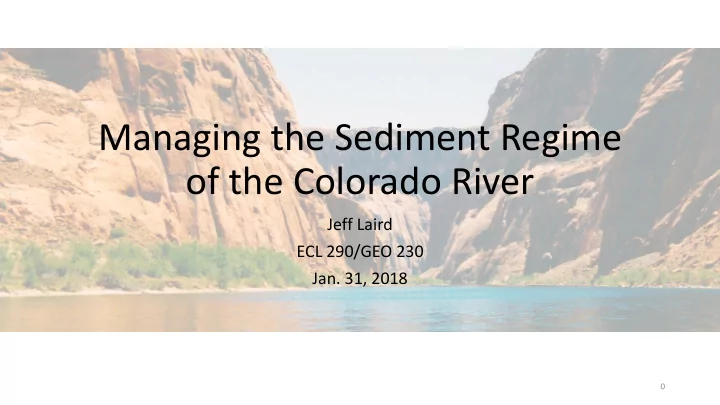

Managing the Sediment Regime of the Colorado River Jeff Laird ECL 290/GEO 230 Jan. 31, 2018 0
Overview • Background Information • Management Plans and their goals • Specific Sediment Resource Goals • High Flow Experiments • Evaluating Results • Conclusions 1
Glen Canyon Dam (Lake Powell) • Colorado River Storage Project, USBR • Finished in 1966 • 108335 mi 2 drainage area • 27 million af capacity (about 2 years annual flow of Colorado River) • 208000 cfs maximum spillway capacity 2
Flow at Lee’s Ferry Before and After Dam 3
Little Colorado Confluence 4
Grand Canyon Protection Act of 1992 • L ong T erm E xperimental and M anagement P lan • Glen Canyon Dam Adaptive Management Program 5
LTEMP Goals • Maintain Archeological and Cultural Resources • Restore Natural Processes • Meet Humpback Chub Recovery Goals (plus other self-sustaining fish) • Maintain or Increase Hydropower Generation • Maintain Recreational Experience • Maintain Tribal Values and Resources • Maintain Healthy Rainbow Trout Fishery in GCNRA • Minimize Invasive Non-native Aquatic Species • Maintain Healthy Riparian Ecosystem 6
Laws of the River Colorado River Compact • Grand Canyon Protection Act • Boulder Canyon Project Act • Endangered Species Act • California Seven Party Agreement • National Environmental Policy Act • Mexican Water Treaty • National Historic Preservation Act • Upper Colorado River Basin Compact • Colorado River Storage Project Act • Arizona v. California et al. • Colorado River Basin Project Act • Criteria For Coordinated Long-Range Operation of Colorado River Reservoirs • Minute 242 of the U.S. - Mexico International Boundary and Water Commission of 1973 • Colorado River Basin Salinity Control Act • 7
Sediment Resource Goals • “Direct, indirect, and cumulative impacts of the effects of the proposed action, in combination with the effects of past, present, and reasonably foreseeable future projects” • Listed goal - “ Increase and retain fine sediment volume, area, and distribution in the Glen, Marble, and Grand Canyon reaches above the elevation of the average base flow for ecological, cultural, and recreational purposes ” • Sand and sandbars in the active river channel, sand and sediment accumulation in the delta at the mouth of Lake Mead 8
High Flow Experiment Protocol • First promoted in 1995, first tests in 1996, 2004, 2008 • “Effects of Three High-Flow Experiments on the Colorado River Ecosystem Downstream from Glen Canyon Dam, Arizona” – Melis 2011 • Reevaluation • Fall HFEs: 2012 – 2014, 2016 9
LTEMP Experimental Action: Sediment- Related Experimental Treatments • HFEs would be implemented as soon as they are triggered, based on sand mass balance estimates from Paria River sediment inputs during the spring and fall accounting periods, to rebuild sandbars. • Sediment-Triggered Spring HFEs beginning in spring of 2020 • Proactive Spring HFEs in years with high annual water volume (i.e., ≥10 maf) in April, May, or June (also wouldn't begin until spring of 2020) • Sediment-Triggered Fall HFEs up to 96 hours • Extended-Duration Fall HFEs up to 250 hours 10
Evaluating the Results: Functional Flows - Ideal Restoration? • Natural Flow Regime Paradigm • Functional Flows • Timing • Magnitude • Frequency • Duration • Rate of Change • “You’re really just trying to make the best of a bad deal” 11
Evaluating the Results: Adaptive Management • ‘Preferred Alternative’ is to adaptively operate Glen Canyon Dam • Before the first HFE, sediment accumulation was thought to be different, subsequent experiments were changed • HFEs in 2004 and 2008 were triggered because of sediment inputs from tributaries, and had much better success • E.g. 2008 HFE increased rainbow trout growth rates and survival by 400% • In the long term, overall inflows are expected to decrease. Flood events could have drastically increased magnitude and variability 12
Conclusions Has dam management “ increased and retained fine sediment volume, area, and distribution in the target reaches for ecological purposes ”? Has it ” restored natural processes ” within the Grand Canyon? Restoring the ecology might be impossible and the management plans are unlikely to drastically change things while balancing multiple objectives. Is a commitment to adaptive management a success in its own right? 13
Recommend
More recommend